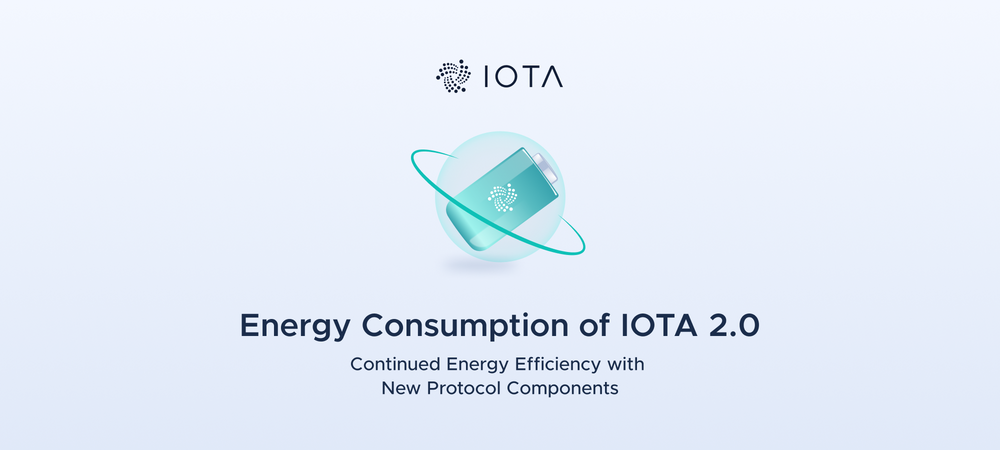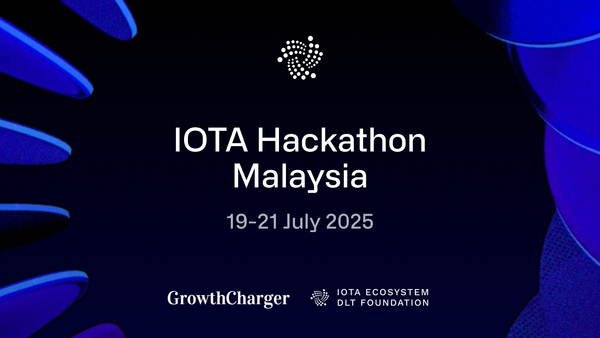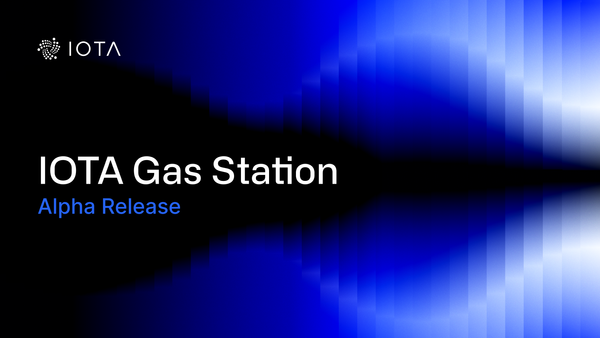Energy Consumption of IOTA 2.0
Continued Energy Efficiency with New Protocol Components
TL;DR:
Tests on the Coordinator-less IOTA 2.0 prototype conclusively show significant reductions in energy consumption for the issuance of messages and a continuation of the overall low energy consumption of the network, making IOTA one of the most environmentally-friendly and sustainable distributed ledger technologies (DLT). A GoShimmer network of 450 Raspberry Pi nodes at a constant network load of 50mps would only consume around 43.30% of the annual energy consumed by a person, and consume 0.000009% of the currently estimated annual energy consumption of the Bitcoin network.
The high energy consumption of Proof of Work (PoW)-based distributed ledgers has become a significant environmental concern. At the time of writing, the Bitcoin network consumes an estimated 204.5 TWh annually, which is around the same as South Africa’s annual electricity consumption of 202 TWh. Built upon a directed acyclic graph (DAG) architecture, the IOTA DLT will implement a novel access control algorithm that avoids PoW and thus requires less energy. However, with upcoming protocol changes to IOTA 2.0, energy efficiency claims will have to be continuously backed by new research.
That is precisely what the IOTA Research team has recently completed, and we are publishing a new report that elaborates on the latest findings on the energy consumption of the IOTA 2.0 prototype.
Our study
The node software prototype testing the waters for the Coordinator-less IOTA 2.0 is called GoShimmer. To measure the energy consumption of a private GoShimmer network, we ran several tests on a Raspberry Pi 4B, which is a small, low-powered computer.

Our findings reveal that powering a single transaction on the upcoming IOTA 2.0 prototype takes less energy than lighting one festive light for just a second.
That’s one of the surprising implications of the new research into the energy-saving optimizations that come with the IOTA 2.0 prototype. Specifically, the research finds that when simulating the removal of Proof of Work (PoW) as the network’s method of spam protection with the IOTA Congestion Control Algorithm (ICCA), the energy consumption required for issuing a message in GoShimmer is significantly improved.
Results of tests conducted with GoShimmer show that the energy consumption of a single data transaction on one node with a network activity of 50 messages per second (mps) is just 0.00678 joule. One joule is equal to one watt-second, which is the energy required to illuminate a Christmas tree light for one second. One joule is also the amount of kinetic energy gained when dropping a tomato from a height of roughly one meter. The table below shows the results of the two main energy consumption metrics compared to running a 1W LED for one second.
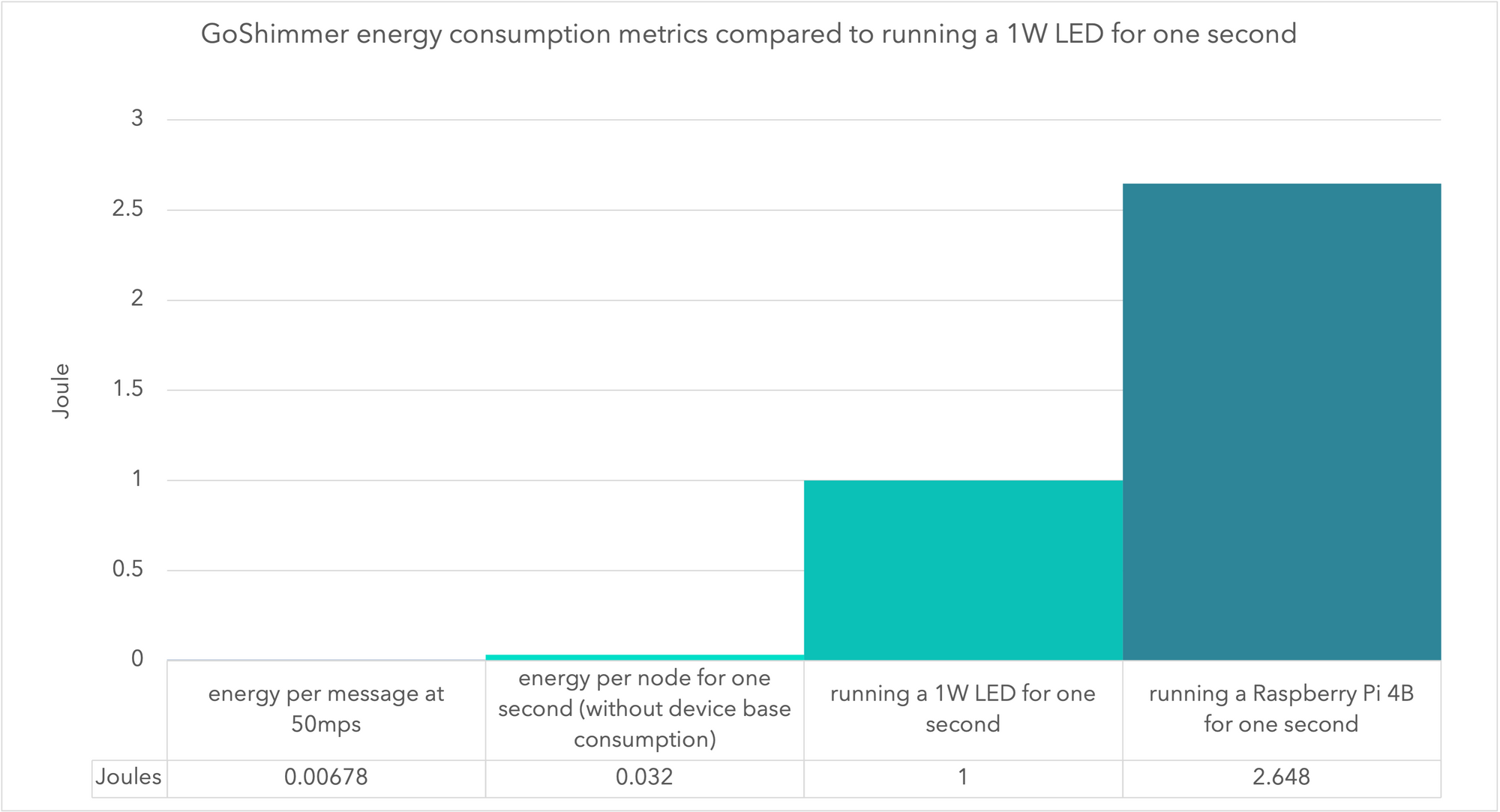
One should note that when comparing the energy per message and node metrics, the energy consumption of the hardware device on which the nodes are running should also be taken into consideration. A message cannot be processed without the necessary hardware energy consumption. For example, the table above shows that the Raspberry Pi consumes a bit more than 2W, which is still very low.
The low energy consumption of the IOTA 2.0 prototype is additionally highlighted by our calculations, which show that a hypothetical IOTA network made up of 450 Raspberry Pi nodes working at a constant network load of 50mps would only consume around 43.30% of the annual energy consumption of an average individual in Germany (where the tests were carried out).
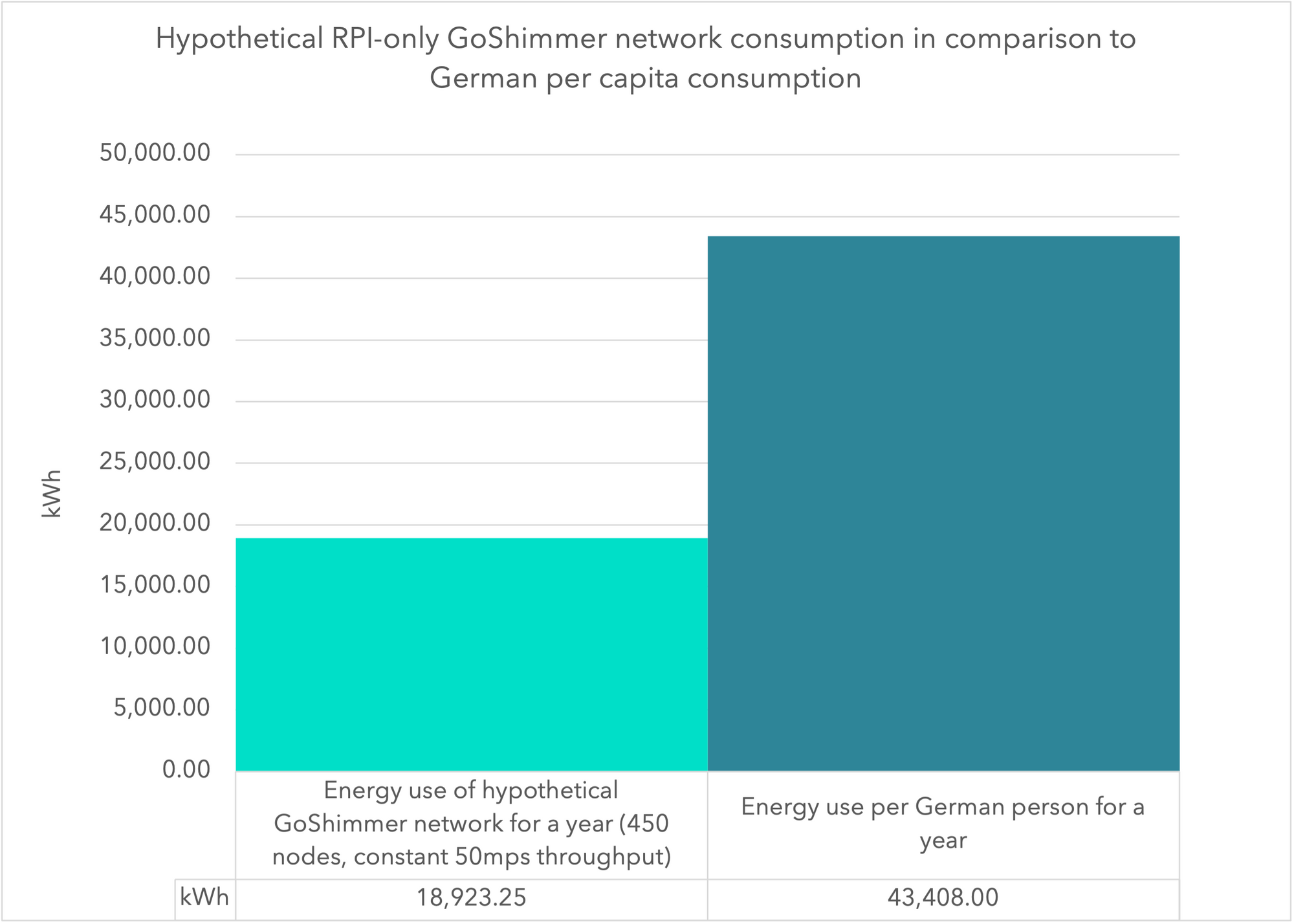
From a different point of view but equally encouraging, the same hypothetical network would only consume 0.000009% of the Bitcoin network’s currently-estimated yearly energy consumption, which is 204.5 TWh at the time of writing.
The recent Chrysalis upgrade of the IOTA protocol brought improvements to the protocol’s energy consumption. To confirm that IOTA 2.0 will remain energy efficient compared to Chrysalis, we conducted several tests.
These tests study a scenario where there is no PoW in IOTA 2.0. Our results show that the energy consumption required to process a data transaction at a 50mps throughput is 0.00678 joules, which is 99.83% less than the energy consumed by issuing a transaction with PoW in Chrysalis, the most recent IOTA upgrade (which consumes 4,025 [J] per transaction, as shown in Table 1). Below is a comparison of the results to the previous Chrysalis benchmarking.
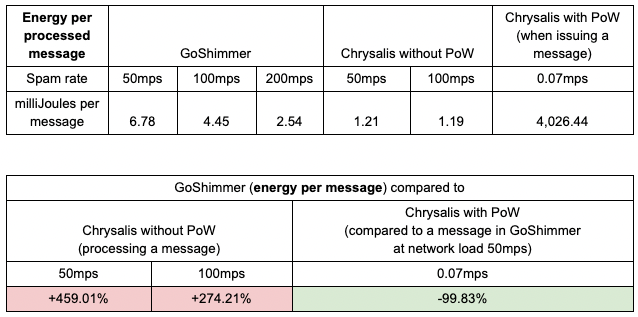
When comparing GoShimmer to Chrysalis with PoW, we observe a drastic reduction in the energy consumed by issuing a transaction. However, the energy consumption level when processing a message is higher in GoShimmer as seen in the Chrysalis without PoW column. This can be explained by the new consensus-related modules and other components in GoShimmer. Previously, consensus in the Chrysalis network is achieved when a message is referenced by a milestone message from the Coordinator. With the Coordinator removed in GoShimmer, there are now more complex processes in place that can require more energy.
The reduction in energy consumption for issuing a message when comparing GoShimmer to Chrysalis is particularly significant in smaller networks, while for very large networks and the current PoW difficulty, the energy consumption in Chrysalis may be less than in GoShimmer. Consider a network of 100 nodes: when a node issues a message, the message must also be processed 99 times by the receiving nodes even though it only has to be issued once. As a consequence, the energy consumption required for processing a message in larger networks can negate any reduction in the energy required to issue the message. In addition to network size, the overall energy consumption of a network also depends on the hardware that is used. Indeed, most nodes on the IOTA mainnet are run on servers from data center providers, while the nodes in our hypothetical network are all considered to run on energy-efficient Raspberry Pi computers. As a consequence, the study should be understood as providing only an impression of the energy consumption scale at which IOTA 2.0 will operate.
To see what effect the improvement in energy consumption for issuing a message has on the overall energy consumption, we compared the previously-used GoShimmer network to a Chrysalis network with the same parameters, as shown in the graph below.
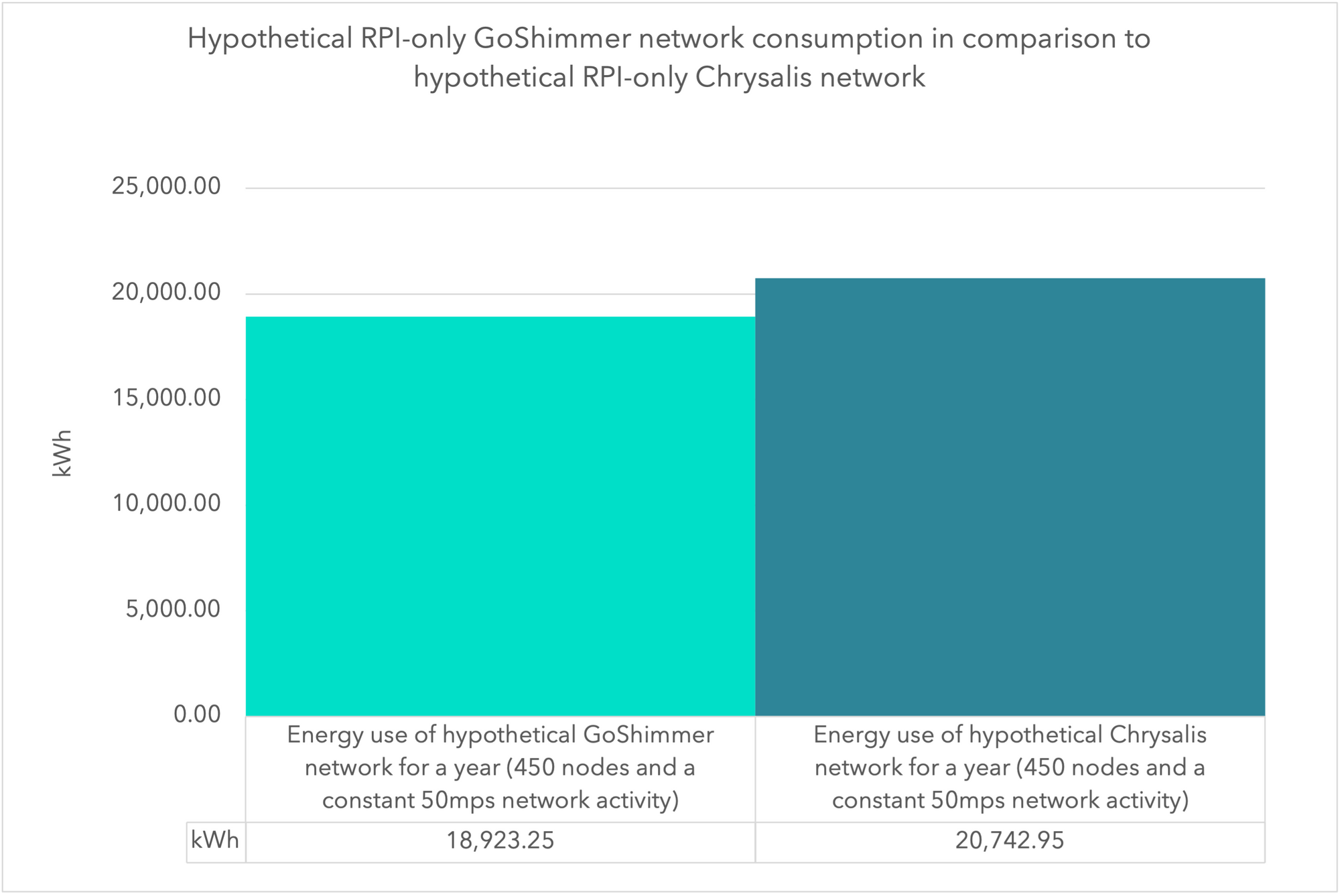
The graph shows a scenario with 450 nodes at a throughput of 50 mps, at which the two networks consume approximately the same energy. This example highlights the above-mentioned effect, where improvement in the energy consumption of issuing a message becomes insignificant in larger networks. Although this might seem disappointing at first sight, these findings are in fact great news, because it shows that, despite GoShimmer having increased in complexity due to new protocol components, it still consumes approximately the same energy as Chrysalis! Moreover, the prototype code has yet to undergo improvements similar to the current mainnet node software upgrades that were brought about by Chrysalis. As such the IOTA 2.0 solution has additional room for energy efficiency improvements. Also, it is possible that the PoW difficulty in Chrysalis may have to be increased if the network becomes subject to spam attacks, thus increasing the energy consumed.
Overall the findings are great news, as the current IOTA mainnet shows a similar amount of nodes and network activity to the values used in the hypothetical IOTA network calculations. Moreover, GoShimmer is a research prototype, and can yet be optimized to improve efficiency. This provides an optimistic outlook for the future, as we can expect further improvements to the energy consumption of IOTA.
A greener DLT
These findings are good news for anyone concerned about the environmental impact of blockchain and other DLTs. And people are right to be worried about distributed ledgers that use Proof of Work (PoW) as a consensus mechanism: such systems are known to be major contributors to environmental problems as they consume immense amounts of energy and produce lots of electronic waste. Especially given the urgency of climate change, we must re-evaluate the energy consumption and efficiency of the products and services that underpin our daily lives, including, increasingly, DLT.
With the publication of our new research into the IOTA 2.0 prototype, we highlight that, because of its low energy use, IOTA 2.0 has a minimal environmental impact. This shows that, in contrast to DLTs that use PoW, certain DLTs can help achieve climate goals when used as part of digital sustainability solutions.
For example, the IOTA Foundation collaborates with a global ecosystem of partners to research and develop sustainable technologies for use in industry, trade, mobility, smart cities, and more. Examples include Digital MRV, a collaboration with ClimateCHECK to digitize the measurement, reporting, and verification of sustainability performance, and the Trade Logistics Information Pipeline (TLIP) in cooperation with TradeMark East Africa, which improves the livelihoods of East African traders by building a digital infrastructure for the exchange of data in cross-border processes.
It is essential that digital solutions for sustainability, such as Digital MRV and TLIP, do not themselves have high energy usage. Due to its lightweight and energy-efficient nature, the IOTA DLT is ideal for this task.
Outlook and future research
Having updated energy data for the future IOTA 2.0 protocol upgrade confirms that IOTA continues to have a low environmental impact through its low energy use. We believe that transparency on energy consumption metrics is vital, as it enables regulators, institutions, and investors to make more educated decisions about the DLT sector. We also hope that, by publicly sharing our energy consumption profile, we will hopefully motivate other projects to conduct their own energy consumption analysis.
As the IOTA technology advances, so should the research into its environmental impact. The current results should thus not be seen as a final destination for research into IOTA 2.0’s energy consumption. Future research can focus on providing an accurate annual figure showing the energy consumption of the IOTA mainnet, which would be beneficial for comparisons with other protocols. Moreover, an analysis of GoShimmer and its energy consumption will be used to publish updates about the figures presented in this blog post.
If you're interested in more information about the research, read the full report here. To keep up to date with the latest from the IOTA Research team, visit the research page on the newly launched IOTA Governance forum.

